Comprehensive Stakeholder Analysis of Samsung: A Business Report
VerifiedAdded on 2022/09/26
|18
|3623
|60
Report
AI Summary
This report provides a comprehensive stakeholder analysis of Samsung, a multinational conglomerate. It begins with an executive summary and introduction outlining Samsung's history, diversification, and global valuation. The analysis delves into both internal and external stakeholders, utilizing PESTLE analysis to identify political, economic, social, technological, environmental, and legal factors influencing the company. The report examines the impact of government policies, economic fluctuations, social trends, technological advancements, environmental concerns, and legal challenges on Samsung's operations and financial performance. It identifies key external stakeholders, including governments, customers, suppliers, and shareholders. Furthermore, the report explores internal stakeholders, such as board members, employees, and management, highlighting their roles and influence. A stakeholder matrix is used to visualize the power, interests, and engagement strategies related to each stakeholder group. The report also briefly compares Samsung's stakeholder dynamics with those of its rival, Apple Inc., before concluding with a summary of findings and recommendations. The report aims to identify the most important stakeholders and how they influence the company's decision-making processes, with a focus on mitigating associated problems.

Running head: STAKEHOLDER ANALYSIS OF SAMSUNG
STAKEHOLDER ANALYSIS OF SAMSUNG
Name of Student
Name of University
Author’s Note
STAKEHOLDER ANALYSIS OF SAMSUNG
Name of Student
Name of University
Author’s Note
Paraphrase This Document
Need a fresh take? Get an instant paraphrase of this document with our AI Paraphraser

1STAKEHOLDER ANALYSIS OF SAMSUNG
EXECUTIVE SUMMARY:
This report discusses about the importance of the stakeholder in a company. In order to identify
the importance of the stakeholders of the company, stakeholder matrix and PESTLE analysis are
being conducted. Samsung is taken as the example for understanding the importance of the
stakeholder of the company. The discussion is made based on the internal and external
stakeholder of the company. The report also tries to identify most important stakeholder that
determines the company’s decisions. The report also discusses about the dominant stakeholder of
Samsung’s rival company, Apple Inc.
EXECUTIVE SUMMARY:
This report discusses about the importance of the stakeholder in a company. In order to identify
the importance of the stakeholders of the company, stakeholder matrix and PESTLE analysis are
being conducted. Samsung is taken as the example for understanding the importance of the
stakeholder of the company. The discussion is made based on the internal and external
stakeholder of the company. The report also tries to identify most important stakeholder that
determines the company’s decisions. The report also discusses about the dominant stakeholder of
Samsung’s rival company, Apple Inc.
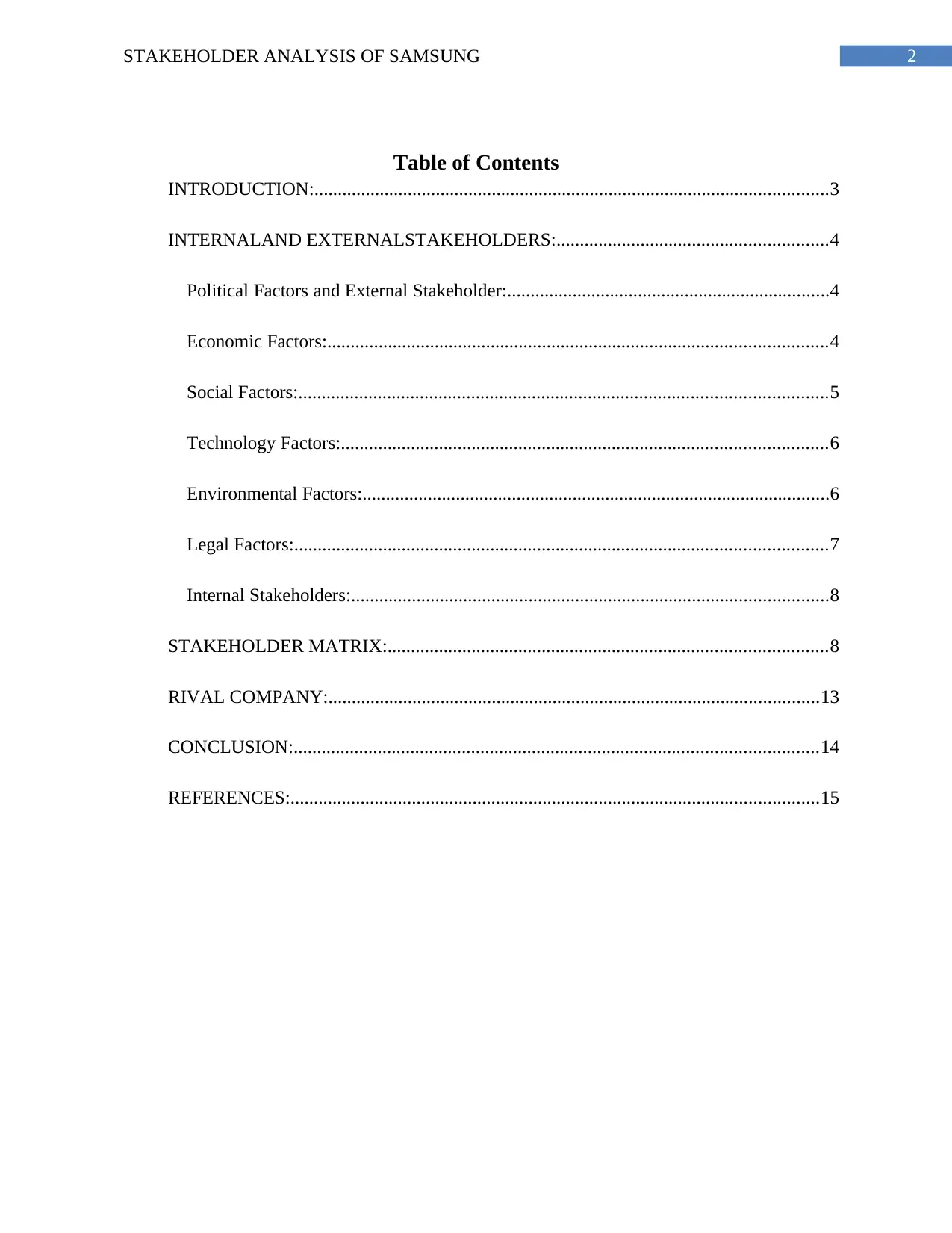
2STAKEHOLDER ANALYSIS OF SAMSUNG
Table of Contents
INTRODUCTION:..............................................................................................................3
INTERNALAND EXTERNALSTAKEHOLDERS:..........................................................4
Political Factors and External Stakeholder:.....................................................................4
Economic Factors:...........................................................................................................4
Social Factors:.................................................................................................................5
Technology Factors:........................................................................................................6
Environmental Factors:....................................................................................................6
Legal Factors:..................................................................................................................7
Internal Stakeholders:......................................................................................................8
STAKEHOLDER MATRIX:..............................................................................................8
RIVAL COMPANY:.........................................................................................................13
CONCLUSION:................................................................................................................14
REFERENCES:.................................................................................................................15
Table of Contents
INTRODUCTION:..............................................................................................................3
INTERNALAND EXTERNALSTAKEHOLDERS:..........................................................4
Political Factors and External Stakeholder:.....................................................................4
Economic Factors:...........................................................................................................4
Social Factors:.................................................................................................................5
Technology Factors:........................................................................................................6
Environmental Factors:....................................................................................................6
Legal Factors:..................................................................................................................7
Internal Stakeholders:......................................................................................................8
STAKEHOLDER MATRIX:..............................................................................................8
RIVAL COMPANY:.........................................................................................................13
CONCLUSION:................................................................................................................14
REFERENCES:.................................................................................................................15
⊘ This is a preview!⊘
Do you want full access?
Subscribe today to unlock all pages.

Trusted by 1+ million students worldwide
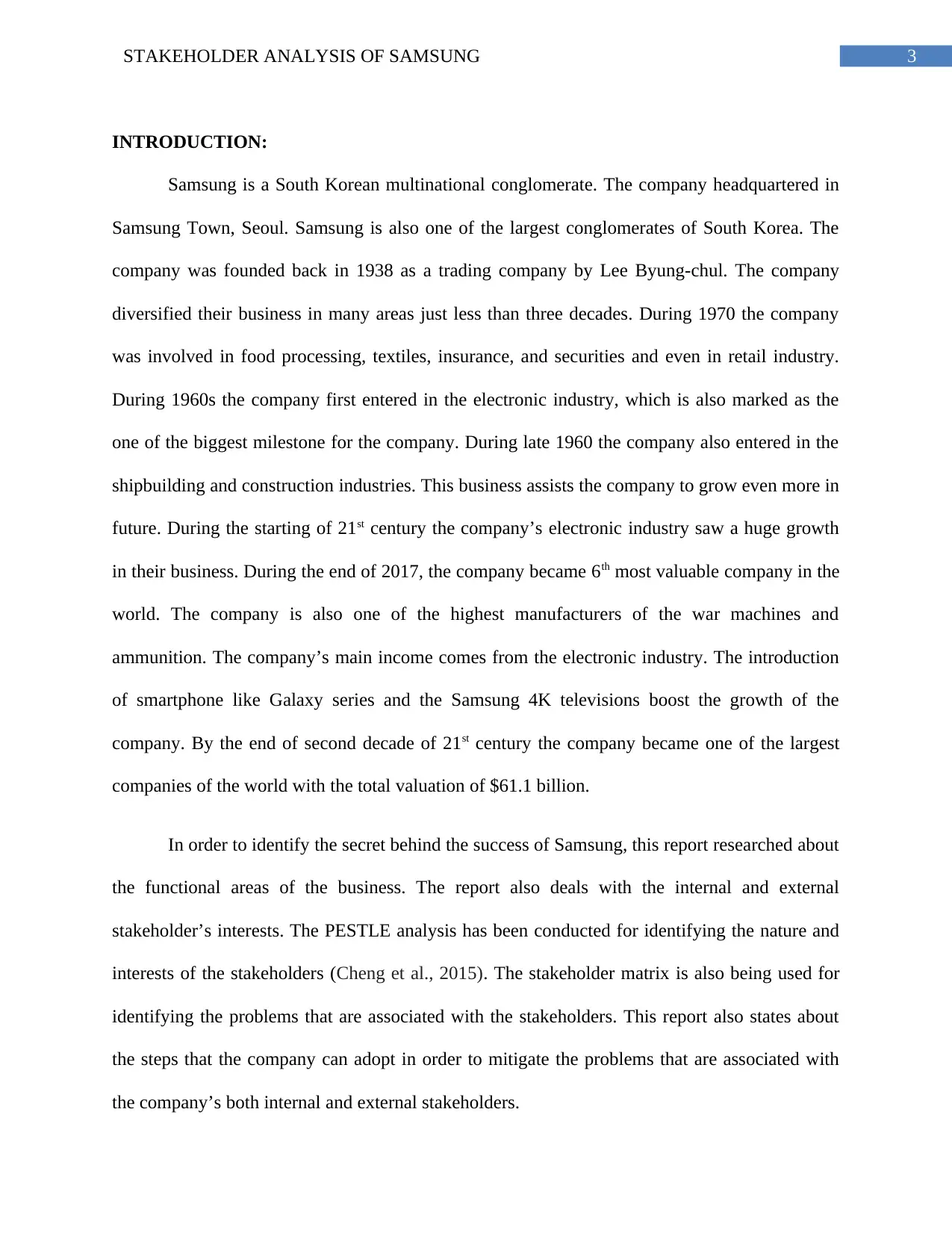
3STAKEHOLDER ANALYSIS OF SAMSUNG
INTRODUCTION:
Samsung is a South Korean multinational conglomerate. The company headquartered in
Samsung Town, Seoul. Samsung is also one of the largest conglomerates of South Korea. The
company was founded back in 1938 as a trading company by Lee Byung-chul. The company
diversified their business in many areas just less than three decades. During 1970 the company
was involved in food processing, textiles, insurance, and securities and even in retail industry.
During 1960s the company first entered in the electronic industry, which is also marked as the
one of the biggest milestone for the company. During late 1960 the company also entered in the
shipbuilding and construction industries. This business assists the company to grow even more in
future. During the starting of 21st century the company’s electronic industry saw a huge growth
in their business. During the end of 2017, the company became 6th most valuable company in the
world. The company is also one of the highest manufacturers of the war machines and
ammunition. The company’s main income comes from the electronic industry. The introduction
of smartphone like Galaxy series and the Samsung 4K televisions boost the growth of the
company. By the end of second decade of 21st century the company became one of the largest
companies of the world with the total valuation of $61.1 billion.
In order to identify the secret behind the success of Samsung, this report researched about
the functional areas of the business. The report also deals with the internal and external
stakeholder’s interests. The PESTLE analysis has been conducted for identifying the nature and
interests of the stakeholders (Cheng et al., 2015). The stakeholder matrix is also being used for
identifying the problems that are associated with the stakeholders. This report also states about
the steps that the company can adopt in order to mitigate the problems that are associated with
the company’s both internal and external stakeholders.
INTRODUCTION:
Samsung is a South Korean multinational conglomerate. The company headquartered in
Samsung Town, Seoul. Samsung is also one of the largest conglomerates of South Korea. The
company was founded back in 1938 as a trading company by Lee Byung-chul. The company
diversified their business in many areas just less than three decades. During 1970 the company
was involved in food processing, textiles, insurance, and securities and even in retail industry.
During 1960s the company first entered in the electronic industry, which is also marked as the
one of the biggest milestone for the company. During late 1960 the company also entered in the
shipbuilding and construction industries. This business assists the company to grow even more in
future. During the starting of 21st century the company’s electronic industry saw a huge growth
in their business. During the end of 2017, the company became 6th most valuable company in the
world. The company is also one of the highest manufacturers of the war machines and
ammunition. The company’s main income comes from the electronic industry. The introduction
of smartphone like Galaxy series and the Samsung 4K televisions boost the growth of the
company. By the end of second decade of 21st century the company became one of the largest
companies of the world with the total valuation of $61.1 billion.
In order to identify the secret behind the success of Samsung, this report researched about
the functional areas of the business. The report also deals with the internal and external
stakeholder’s interests. The PESTLE analysis has been conducted for identifying the nature and
interests of the stakeholders (Cheng et al., 2015). The stakeholder matrix is also being used for
identifying the problems that are associated with the stakeholders. This report also states about
the steps that the company can adopt in order to mitigate the problems that are associated with
the company’s both internal and external stakeholders.
Paraphrase This Document
Need a fresh take? Get an instant paraphrase of this document with our AI Paraphraser

4STAKEHOLDER ANALYSIS OF SAMSUNG
INTERNALAND EXTERNALSTAKEHOLDERS:
In order to identify the external stakeholders of Samsung, PESTEL analysis has been
conducted. PESTEL analysis assists the company to examine the affecting factors that affects the
company’s financial position in the market. PESTEL analysis assists to identify the political,
social, economic, and technological legal and environmental factors (Davis & Franks, 2014).
These factors also assist the management of the company to identify the external stakeholders of
the company. Thus, below is the PESTEL analysis that states about the external factors and also
identifies the external stakeholders of the company.
Political Factors and External Stakeholder:
Samsung is one of the established companies in the world. In order to maintain their
business Samsung needs to follow the rules and regulations of the country in which the company
is doing their business (Dreyer et al., 2017). The change in government may also leads to change
in the policies of the company. The changing policies may directly affect the company’s
operations, which will leads to affect the financial performance of the company. The change in
policies of the government may also affect the company’s sustainability in that country. After the
selection of new president of America, many policies regarding the business changes, which
directly affects the operations of the business of Samsung. Thus, it can be stated that the
government is the external stakeholder of Samsung and the decisions passed by them directly
affects the business operations.
Economic Factors:
The economic factor also plays a major role in the sustainability of the business. The shift
in the economic condition may affect the business of the company. The change in the price of the
foreign currency also affects the financial position of the business (Erzurumlu & Erzurumlu,
INTERNALAND EXTERNALSTAKEHOLDERS:
In order to identify the external stakeholders of Samsung, PESTEL analysis has been
conducted. PESTEL analysis assists the company to examine the affecting factors that affects the
company’s financial position in the market. PESTEL analysis assists to identify the political,
social, economic, and technological legal and environmental factors (Davis & Franks, 2014).
These factors also assist the management of the company to identify the external stakeholders of
the company. Thus, below is the PESTEL analysis that states about the external factors and also
identifies the external stakeholders of the company.
Political Factors and External Stakeholder:
Samsung is one of the established companies in the world. In order to maintain their
business Samsung needs to follow the rules and regulations of the country in which the company
is doing their business (Dreyer et al., 2017). The change in government may also leads to change
in the policies of the company. The changing policies may directly affect the company’s
operations, which will leads to affect the financial performance of the company. The change in
policies of the government may also affect the company’s sustainability in that country. After the
selection of new president of America, many policies regarding the business changes, which
directly affects the operations of the business of Samsung. Thus, it can be stated that the
government is the external stakeholder of Samsung and the decisions passed by them directly
affects the business operations.
Economic Factors:
The economic factor also plays a major role in the sustainability of the business. The shift
in the economic condition may affect the business of the company. The change in the price of the
foreign currency also affects the financial position of the business (Erzurumlu & Erzurumlu,
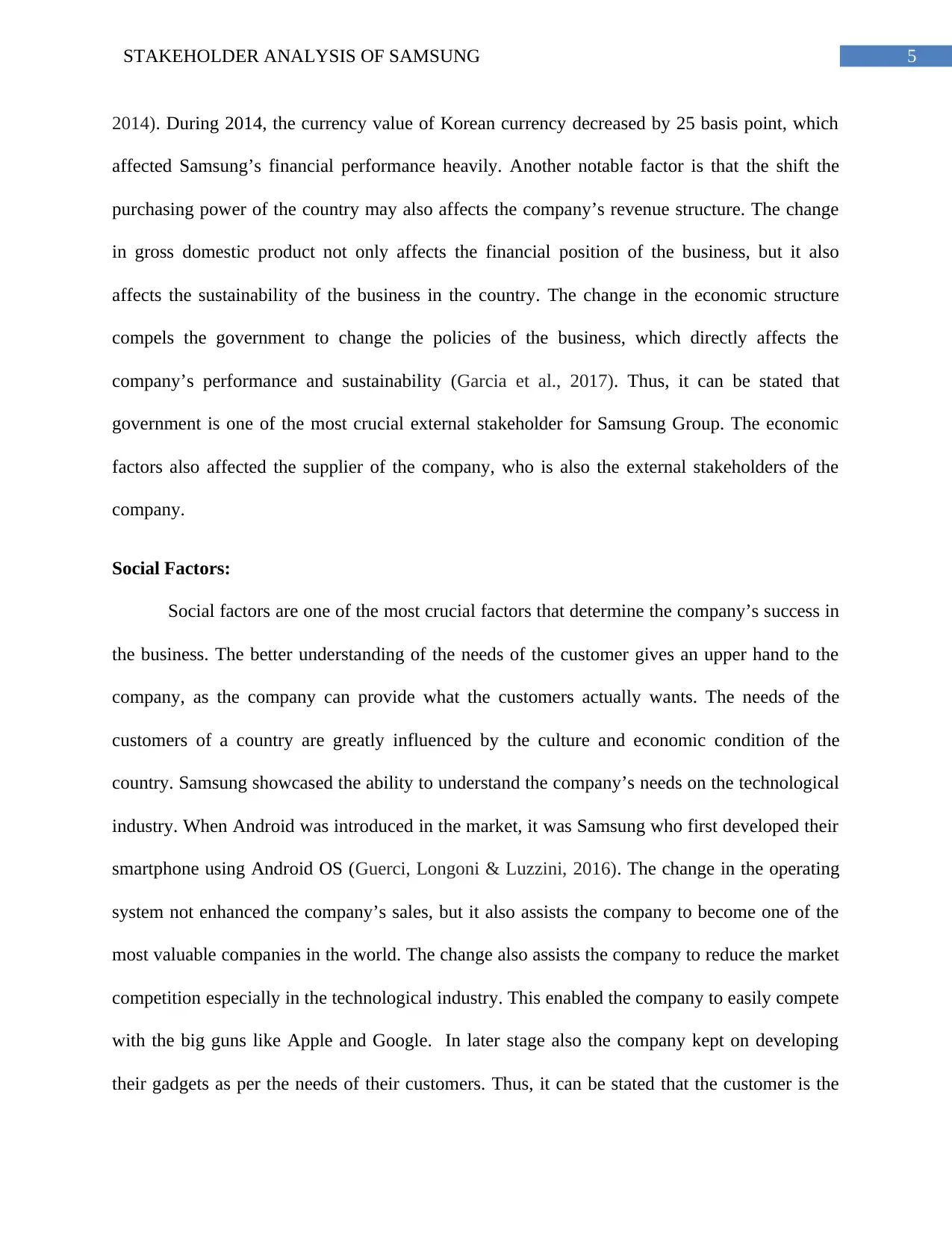
5STAKEHOLDER ANALYSIS OF SAMSUNG
2014). During 2014, the currency value of Korean currency decreased by 25 basis point, which
affected Samsung’s financial performance heavily. Another notable factor is that the shift the
purchasing power of the country may also affects the company’s revenue structure. The change
in gross domestic product not only affects the financial position of the business, but it also
affects the sustainability of the business in the country. The change in the economic structure
compels the government to change the policies of the business, which directly affects the
company’s performance and sustainability (Garcia et al., 2017). Thus, it can be stated that
government is one of the most crucial external stakeholder for Samsung Group. The economic
factors also affected the supplier of the company, who is also the external stakeholders of the
company.
Social Factors:
Social factors are one of the most crucial factors that determine the company’s success in
the business. The better understanding of the needs of the customer gives an upper hand to the
company, as the company can provide what the customers actually wants. The needs of the
customers of a country are greatly influenced by the culture and economic condition of the
country. Samsung showcased the ability to understand the company’s needs on the technological
industry. When Android was introduced in the market, it was Samsung who first developed their
smartphone using Android OS (Guerci, Longoni & Luzzini, 2016). The change in the operating
system not enhanced the company’s sales, but it also assists the company to become one of the
most valuable companies in the world. The change also assists the company to reduce the market
competition especially in the technological industry. This enabled the company to easily compete
with the big guns like Apple and Google. In later stage also the company kept on developing
their gadgets as per the needs of their customers. Thus, it can be stated that the customer is the
2014). During 2014, the currency value of Korean currency decreased by 25 basis point, which
affected Samsung’s financial performance heavily. Another notable factor is that the shift the
purchasing power of the country may also affects the company’s revenue structure. The change
in gross domestic product not only affects the financial position of the business, but it also
affects the sustainability of the business in the country. The change in the economic structure
compels the government to change the policies of the business, which directly affects the
company’s performance and sustainability (Garcia et al., 2017). Thus, it can be stated that
government is one of the most crucial external stakeholder for Samsung Group. The economic
factors also affected the supplier of the company, who is also the external stakeholders of the
company.
Social Factors:
Social factors are one of the most crucial factors that determine the company’s success in
the business. The better understanding of the needs of the customer gives an upper hand to the
company, as the company can provide what the customers actually wants. The needs of the
customers of a country are greatly influenced by the culture and economic condition of the
country. Samsung showcased the ability to understand the company’s needs on the technological
industry. When Android was introduced in the market, it was Samsung who first developed their
smartphone using Android OS (Guerci, Longoni & Luzzini, 2016). The change in the operating
system not enhanced the company’s sales, but it also assists the company to become one of the
most valuable companies in the world. The change also assists the company to reduce the market
competition especially in the technological industry. This enabled the company to easily compete
with the big guns like Apple and Google. In later stage also the company kept on developing
their gadgets as per the needs of their customers. Thus, it can be stated that the customer is the
⊘ This is a preview!⊘
Do you want full access?
Subscribe today to unlock all pages.

Trusted by 1+ million students worldwide
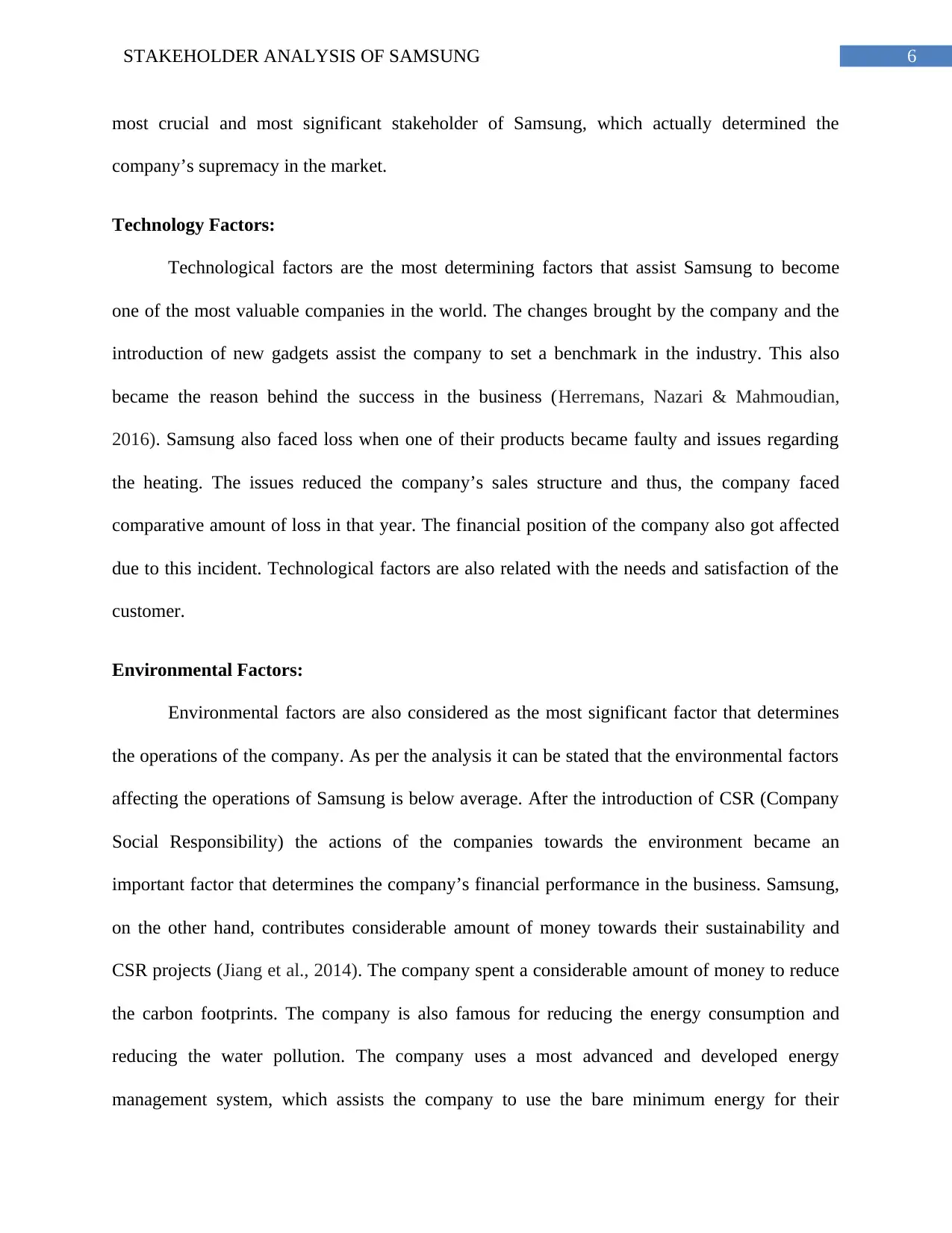
6STAKEHOLDER ANALYSIS OF SAMSUNG
most crucial and most significant stakeholder of Samsung, which actually determined the
company’s supremacy in the market.
Technology Factors:
Technological factors are the most determining factors that assist Samsung to become
one of the most valuable companies in the world. The changes brought by the company and the
introduction of new gadgets assist the company to set a benchmark in the industry. This also
became the reason behind the success in the business (Herremans, Nazari & Mahmoudian,
2016). Samsung also faced loss when one of their products became faulty and issues regarding
the heating. The issues reduced the company’s sales structure and thus, the company faced
comparative amount of loss in that year. The financial position of the company also got affected
due to this incident. Technological factors are also related with the needs and satisfaction of the
customer.
Environmental Factors:
Environmental factors are also considered as the most significant factor that determines
the operations of the company. As per the analysis it can be stated that the environmental factors
affecting the operations of Samsung is below average. After the introduction of CSR (Company
Social Responsibility) the actions of the companies towards the environment became an
important factor that determines the company’s financial performance in the business. Samsung,
on the other hand, contributes considerable amount of money towards their sustainability and
CSR projects (Jiang et al., 2014). The company spent a considerable amount of money to reduce
the carbon footprints. The company is also famous for reducing the energy consumption and
reducing the water pollution. The company uses a most advanced and developed energy
management system, which assists the company to use the bare minimum energy for their
most crucial and most significant stakeholder of Samsung, which actually determined the
company’s supremacy in the market.
Technology Factors:
Technological factors are the most determining factors that assist Samsung to become
one of the most valuable companies in the world. The changes brought by the company and the
introduction of new gadgets assist the company to set a benchmark in the industry. This also
became the reason behind the success in the business (Herremans, Nazari & Mahmoudian,
2016). Samsung also faced loss when one of their products became faulty and issues regarding
the heating. The issues reduced the company’s sales structure and thus, the company faced
comparative amount of loss in that year. The financial position of the company also got affected
due to this incident. Technological factors are also related with the needs and satisfaction of the
customer.
Environmental Factors:
Environmental factors are also considered as the most significant factor that determines
the operations of the company. As per the analysis it can be stated that the environmental factors
affecting the operations of Samsung is below average. After the introduction of CSR (Company
Social Responsibility) the actions of the companies towards the environment became an
important factor that determines the company’s financial performance in the business. Samsung,
on the other hand, contributes considerable amount of money towards their sustainability and
CSR projects (Jiang et al., 2014). The company spent a considerable amount of money to reduce
the carbon footprints. The company is also famous for reducing the energy consumption and
reducing the water pollution. The company uses a most advanced and developed energy
management system, which assists the company to use the bare minimum energy for their
Paraphrase This Document
Need a fresh take? Get an instant paraphrase of this document with our AI Paraphraser
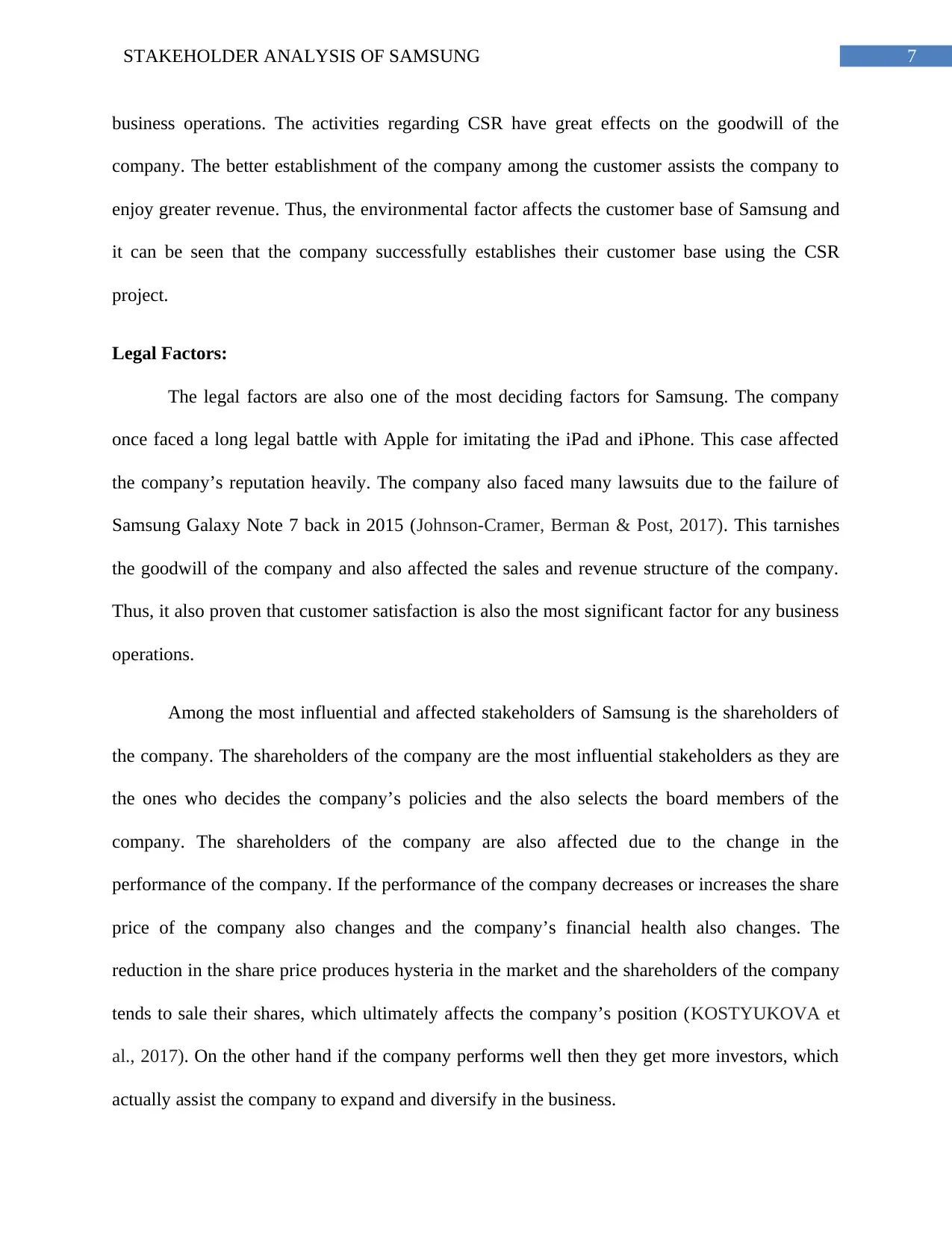
7STAKEHOLDER ANALYSIS OF SAMSUNG
business operations. The activities regarding CSR have great effects on the goodwill of the
company. The better establishment of the company among the customer assists the company to
enjoy greater revenue. Thus, the environmental factor affects the customer base of Samsung and
it can be seen that the company successfully establishes their customer base using the CSR
project.
Legal Factors:
The legal factors are also one of the most deciding factors for Samsung. The company
once faced a long legal battle with Apple for imitating the iPad and iPhone. This case affected
the company’s reputation heavily. The company also faced many lawsuits due to the failure of
Samsung Galaxy Note 7 back in 2015 (Johnson-Cramer, Berman & Post, 2017). This tarnishes
the goodwill of the company and also affected the sales and revenue structure of the company.
Thus, it also proven that customer satisfaction is also the most significant factor for any business
operations.
Among the most influential and affected stakeholders of Samsung is the shareholders of
the company. The shareholders of the company are the most influential stakeholders as they are
the ones who decides the company’s policies and the also selects the board members of the
company. The shareholders of the company are also affected due to the change in the
performance of the company. If the performance of the company decreases or increases the share
price of the company also changes and the company’s financial health also changes. The
reduction in the share price produces hysteria in the market and the shareholders of the company
tends to sale their shares, which ultimately affects the company’s position (KOSTYUKOVA et
al., 2017). On the other hand if the company performs well then they get more investors, which
actually assist the company to expand and diversify in the business.
business operations. The activities regarding CSR have great effects on the goodwill of the
company. The better establishment of the company among the customer assists the company to
enjoy greater revenue. Thus, the environmental factor affects the customer base of Samsung and
it can be seen that the company successfully establishes their customer base using the CSR
project.
Legal Factors:
The legal factors are also one of the most deciding factors for Samsung. The company
once faced a long legal battle with Apple for imitating the iPad and iPhone. This case affected
the company’s reputation heavily. The company also faced many lawsuits due to the failure of
Samsung Galaxy Note 7 back in 2015 (Johnson-Cramer, Berman & Post, 2017). This tarnishes
the goodwill of the company and also affected the sales and revenue structure of the company.
Thus, it also proven that customer satisfaction is also the most significant factor for any business
operations.
Among the most influential and affected stakeholders of Samsung is the shareholders of
the company. The shareholders of the company are the most influential stakeholders as they are
the ones who decides the company’s policies and the also selects the board members of the
company. The shareholders of the company are also affected due to the change in the
performance of the company. If the performance of the company decreases or increases the share
price of the company also changes and the company’s financial health also changes. The
reduction in the share price produces hysteria in the market and the shareholders of the company
tends to sale their shares, which ultimately affects the company’s position (KOSTYUKOVA et
al., 2017). On the other hand if the company performs well then they get more investors, which
actually assist the company to expand and diversify in the business.
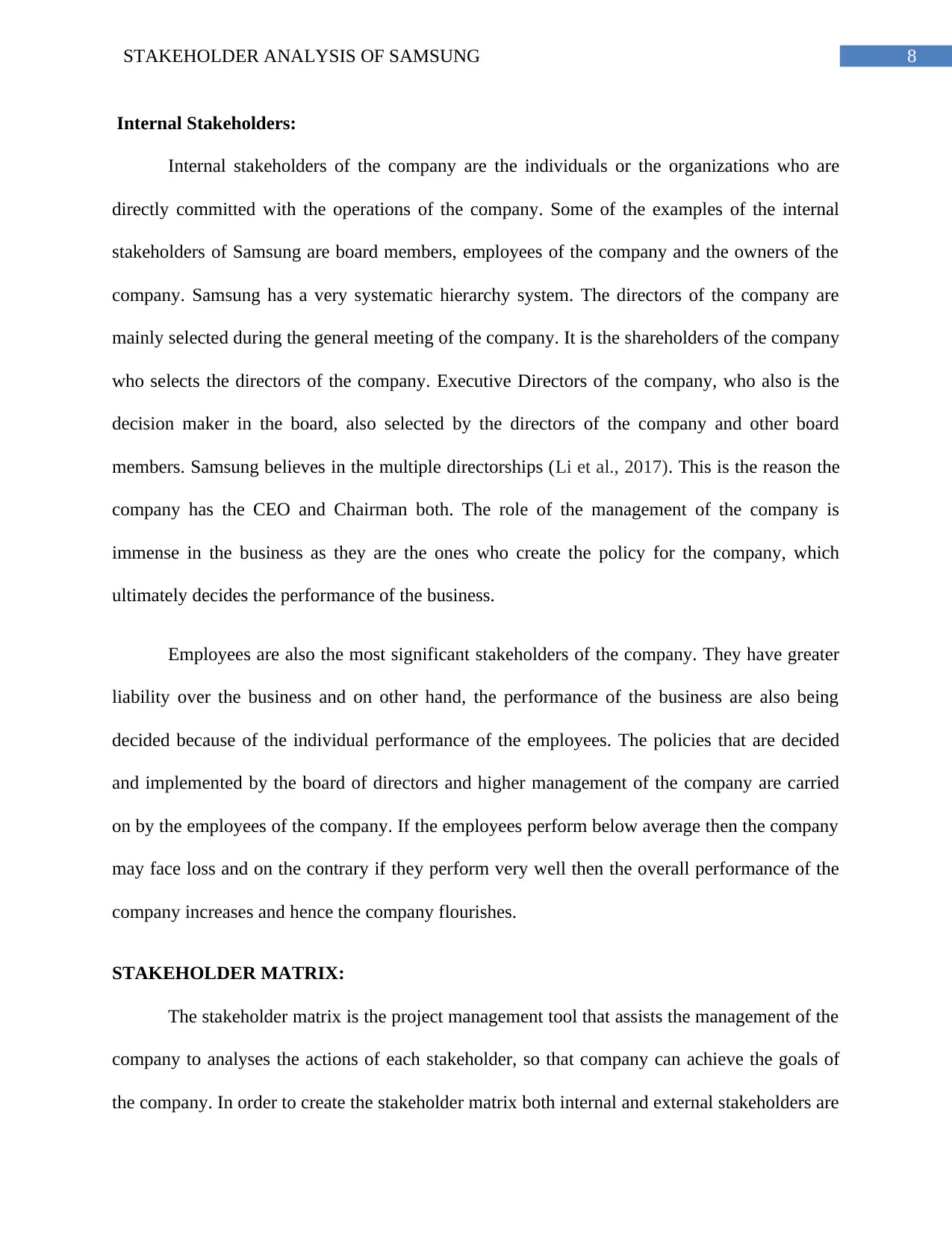
8STAKEHOLDER ANALYSIS OF SAMSUNG
Internal Stakeholders:
Internal stakeholders of the company are the individuals or the organizations who are
directly committed with the operations of the company. Some of the examples of the internal
stakeholders of Samsung are board members, employees of the company and the owners of the
company. Samsung has a very systematic hierarchy system. The directors of the company are
mainly selected during the general meeting of the company. It is the shareholders of the company
who selects the directors of the company. Executive Directors of the company, who also is the
decision maker in the board, also selected by the directors of the company and other board
members. Samsung believes in the multiple directorships (Li et al., 2017). This is the reason the
company has the CEO and Chairman both. The role of the management of the company is
immense in the business as they are the ones who create the policy for the company, which
ultimately decides the performance of the business.
Employees are also the most significant stakeholders of the company. They have greater
liability over the business and on other hand, the performance of the business are also being
decided because of the individual performance of the employees. The policies that are decided
and implemented by the board of directors and higher management of the company are carried
on by the employees of the company. If the employees perform below average then the company
may face loss and on the contrary if they perform very well then the overall performance of the
company increases and hence the company flourishes.
STAKEHOLDER MATRIX:
The stakeholder matrix is the project management tool that assists the management of the
company to analyses the actions of each stakeholder, so that company can achieve the goals of
the company. In order to create the stakeholder matrix both internal and external stakeholders are
Internal Stakeholders:
Internal stakeholders of the company are the individuals or the organizations who are
directly committed with the operations of the company. Some of the examples of the internal
stakeholders of Samsung are board members, employees of the company and the owners of the
company. Samsung has a very systematic hierarchy system. The directors of the company are
mainly selected during the general meeting of the company. It is the shareholders of the company
who selects the directors of the company. Executive Directors of the company, who also is the
decision maker in the board, also selected by the directors of the company and other board
members. Samsung believes in the multiple directorships (Li et al., 2017). This is the reason the
company has the CEO and Chairman both. The role of the management of the company is
immense in the business as they are the ones who create the policy for the company, which
ultimately decides the performance of the business.
Employees are also the most significant stakeholders of the company. They have greater
liability over the business and on other hand, the performance of the business are also being
decided because of the individual performance of the employees. The policies that are decided
and implemented by the board of directors and higher management of the company are carried
on by the employees of the company. If the employees perform below average then the company
may face loss and on the contrary if they perform very well then the overall performance of the
company increases and hence the company flourishes.
STAKEHOLDER MATRIX:
The stakeholder matrix is the project management tool that assists the management of the
company to analyses the actions of each stakeholder, so that company can achieve the goals of
the company. In order to create the stakeholder matrix both internal and external stakeholders are
⊘ This is a preview!⊘
Do you want full access?
Subscribe today to unlock all pages.

Trusted by 1+ million students worldwide
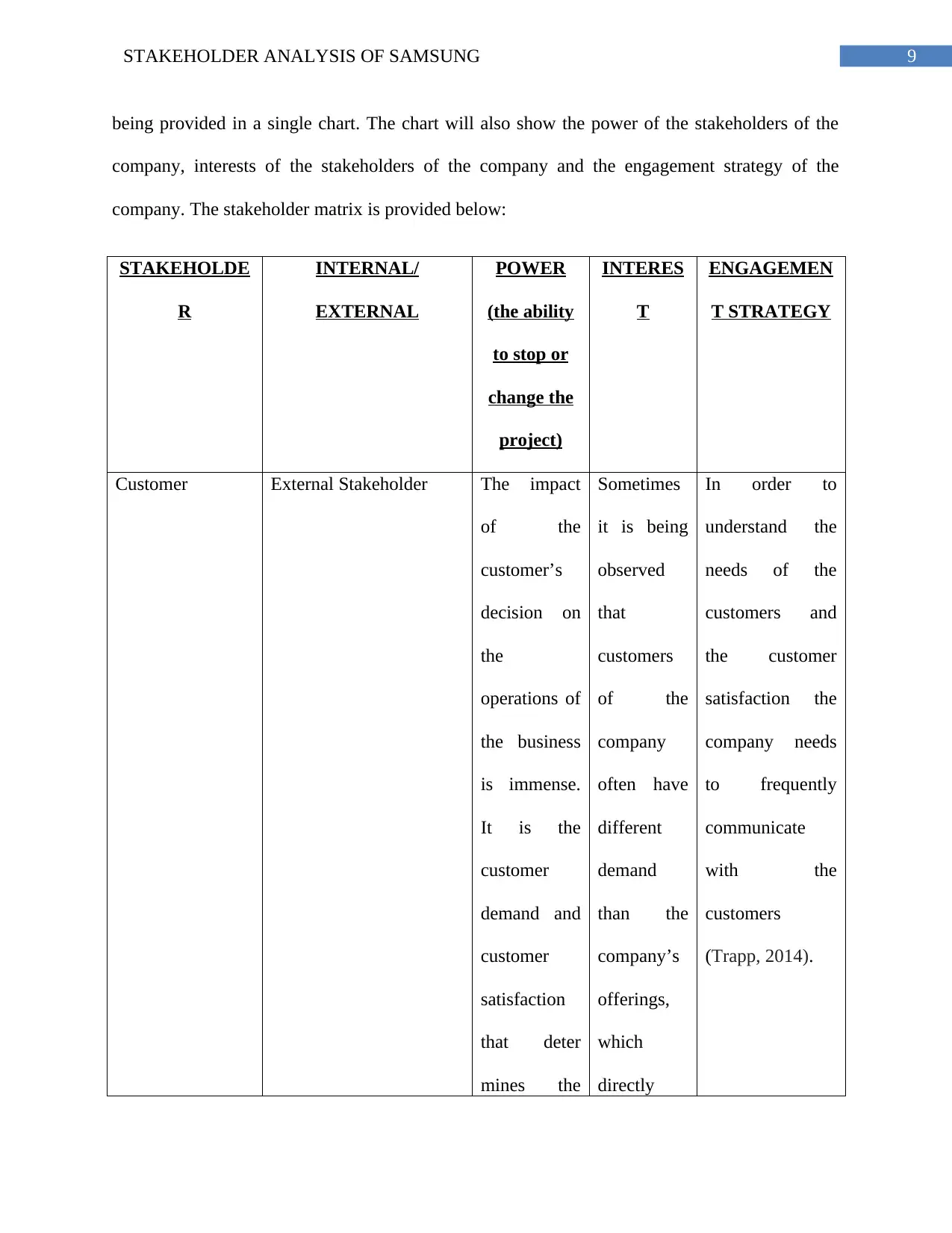
9STAKEHOLDER ANALYSIS OF SAMSUNG
being provided in a single chart. The chart will also show the power of the stakeholders of the
company, interests of the stakeholders of the company and the engagement strategy of the
company. The stakeholder matrix is provided below:
STAKEHOLDE
R
INTERNAL/
EXTERNAL
POWER
(the ability
to stop or
change the
project)
INTERES
T
ENGAGEMEN
T STRATEGY
Customer External Stakeholder The impact
of the
customer’s
decision on
the
operations of
the business
is immense.
It is the
customer
demand and
customer
satisfaction
that deter
mines the
Sometimes
it is being
observed
that
customers
of the
company
often have
different
demand
than the
company’s
offerings,
which
directly
In order to
understand the
needs of the
customers and
the customer
satisfaction the
company needs
to frequently
communicate
with the
customers
(Trapp, 2014).
being provided in a single chart. The chart will also show the power of the stakeholders of the
company, interests of the stakeholders of the company and the engagement strategy of the
company. The stakeholder matrix is provided below:
STAKEHOLDE
R
INTERNAL/
EXTERNAL
POWER
(the ability
to stop or
change the
project)
INTERES
T
ENGAGEMEN
T STRATEGY
Customer External Stakeholder The impact
of the
customer’s
decision on
the
operations of
the business
is immense.
It is the
customer
demand and
customer
satisfaction
that deter
mines the
Sometimes
it is being
observed
that
customers
of the
company
often have
different
demand
than the
company’s
offerings,
which
directly
In order to
understand the
needs of the
customers and
the customer
satisfaction the
company needs
to frequently
communicate
with the
customers
(Trapp, 2014).
Paraphrase This Document
Need a fresh take? Get an instant paraphrase of this document with our AI Paraphraser
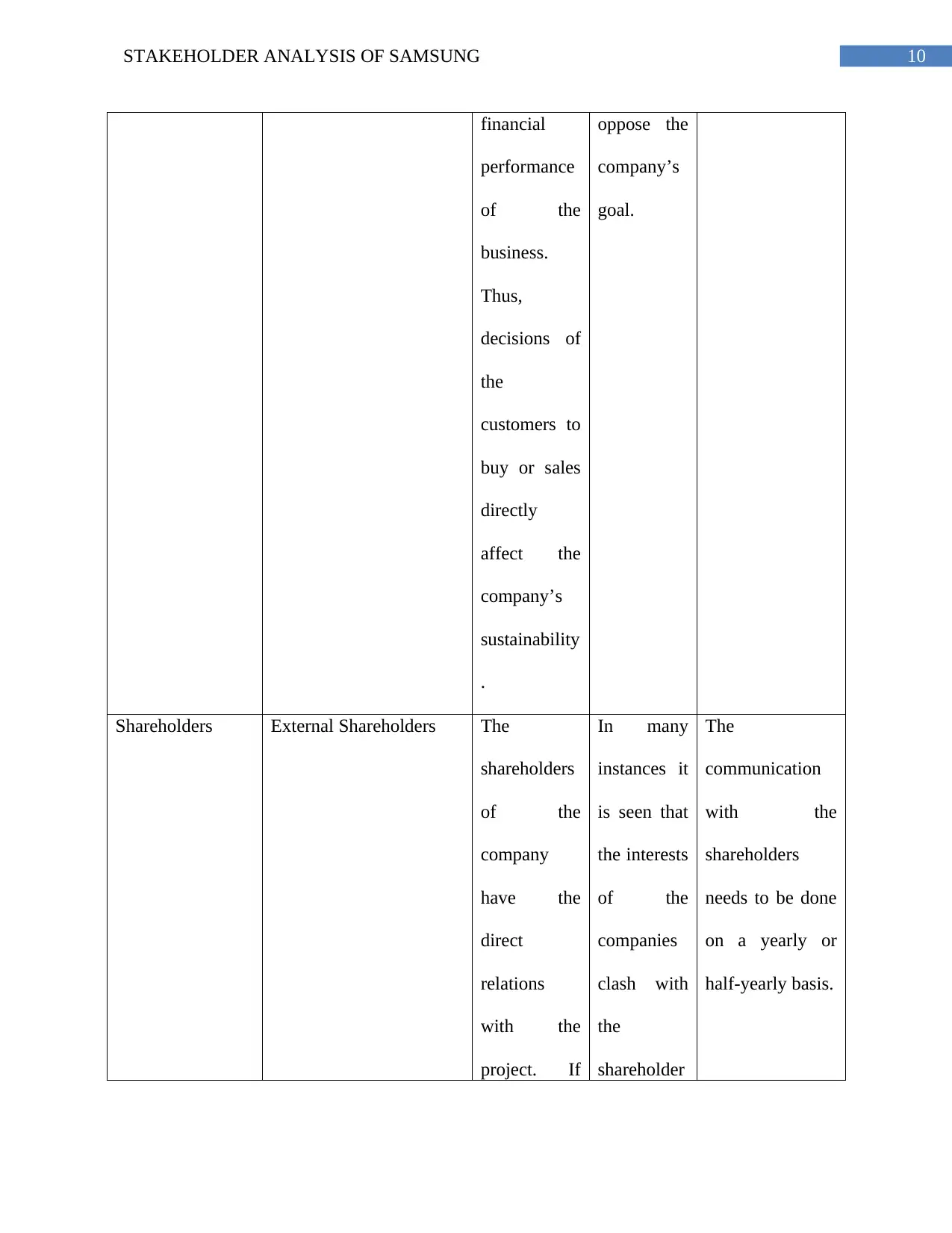
10STAKEHOLDER ANALYSIS OF SAMSUNG
financial
performance
of the
business.
Thus,
decisions of
the
customers to
buy or sales
directly
affect the
company’s
sustainability
.
oppose the
company’s
goal.
Shareholders External Shareholders The
shareholders
of the
company
have the
direct
relations
with the
project. If
In many
instances it
is seen that
the interests
of the
companies
clash with
the
shareholder
The
communication
with the
shareholders
needs to be done
on a yearly or
half-yearly basis.
financial
performance
of the
business.
Thus,
decisions of
the
customers to
buy or sales
directly
affect the
company’s
sustainability
.
oppose the
company’s
goal.
Shareholders External Shareholders The
shareholders
of the
company
have the
direct
relations
with the
project. If
In many
instances it
is seen that
the interests
of the
companies
clash with
the
shareholder
The
communication
with the
shareholders
needs to be done
on a yearly or
half-yearly basis.
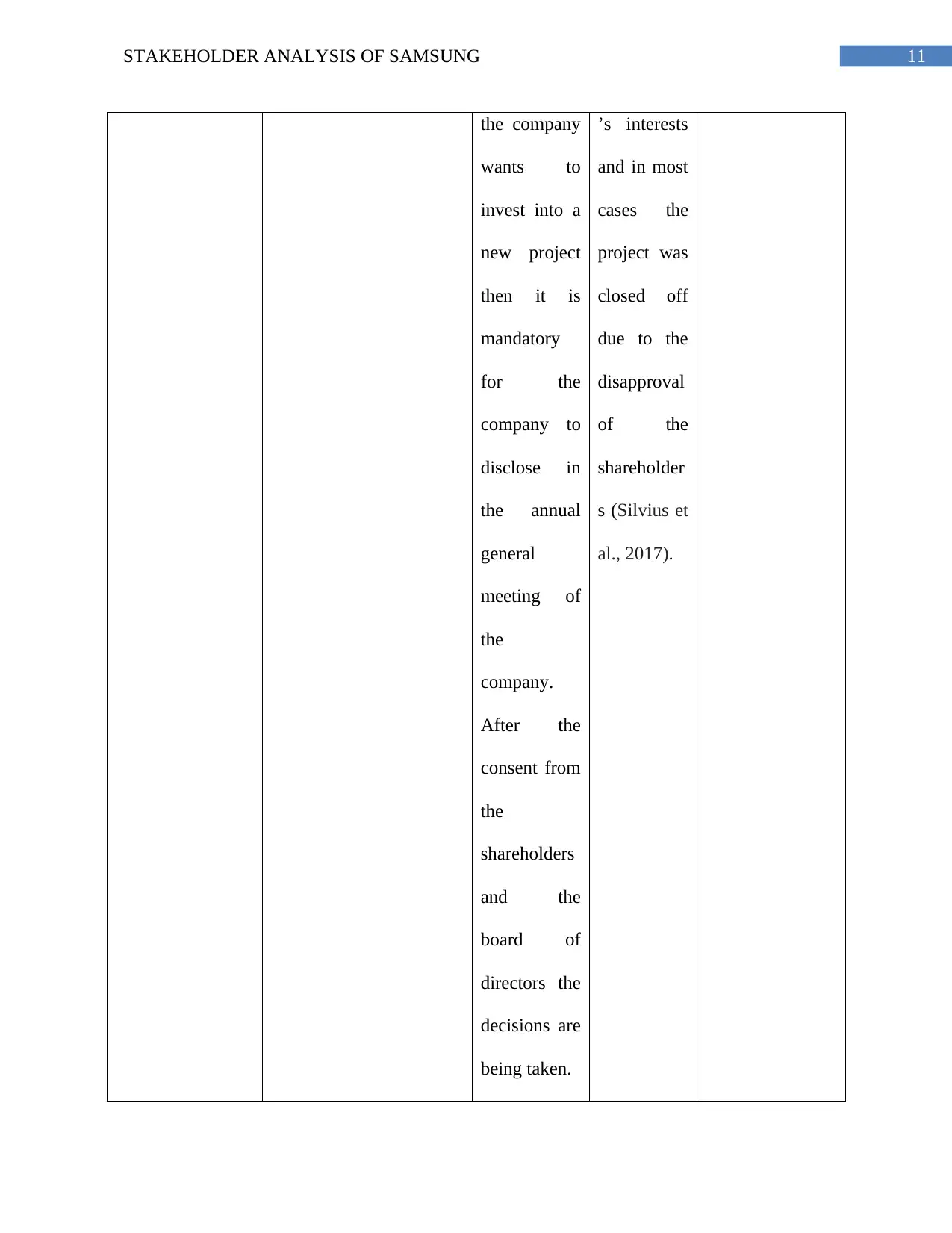
11STAKEHOLDER ANALYSIS OF SAMSUNG
the company
wants to
invest into a
new project
then it is
mandatory
for the
company to
disclose in
the annual
general
meeting of
the
company.
After the
consent from
the
shareholders
and the
board of
directors the
decisions are
being taken.
’s interests
and in most
cases the
project was
closed off
due to the
disapproval
of the
shareholder
s (Silvius et
al., 2017).
the company
wants to
invest into a
new project
then it is
mandatory
for the
company to
disclose in
the annual
general
meeting of
the
company.
After the
consent from
the
shareholders
and the
board of
directors the
decisions are
being taken.
’s interests
and in most
cases the
project was
closed off
due to the
disapproval
of the
shareholder
s (Silvius et
al., 2017).
⊘ This is a preview!⊘
Do you want full access?
Subscribe today to unlock all pages.

Trusted by 1+ million students worldwide
1 out of 18
Related Documents
Your All-in-One AI-Powered Toolkit for Academic Success.
+13062052269
info@desklib.com
Available 24*7 on WhatsApp / Email
![[object Object]](/_next/static/media/star-bottom.7253800d.svg)
Unlock your academic potential
Copyright © 2020–2025 A2Z Services. All Rights Reserved. Developed and managed by ZUCOL.





